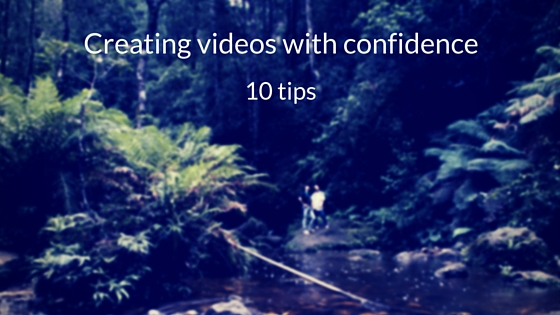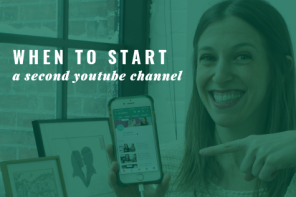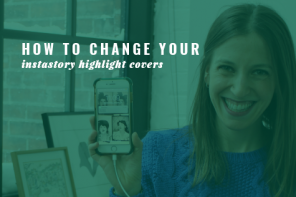Are you trying to use video more in your social media marketing efforts? Struggling with how to create videos with more confidence?
As video grows in importance, power and popularity, the best practices for how to best use it as a vehicle for connecting with your customers will change.
Confidence stems from knowledge; in order to create videos with confidence, you can’t stop learning.
You have to be willing to test new tools and tactics in order to amplify the quality of your videos. By trying new techniques, you can set yourself apart on different video platforms. You can also create unique opportunities to learn from your audience; this allows you to refine your message to be more in line with what you know resonates with your audience.
Last week’s blog post was intended to help you spark ideas for how you can start to use video.
Hopefully, you walked away with a ton of ideas for how video can be a means of education, inspiration and engagement for/with your audience.
This week, I want to arm you with advice that will enable you to remove the technical obstacles present when creating video.
These 10 tips will allow you to be more confident in your video creation, as you’ll become more calm, cool and collected in front of the camera.
Regardless of your budget, industry or level of expertise, the tips below will help you ensure that your videos are created with quality in mind.
Below are 10 tips that you can use to create videos with confidence:
- Sun burns: If shooting video outside, which will be more popular in the spring and summer, be mindful of the lighting. Sunshine is going to set your video on fire, and not in a good way; when standing in the sun, it’s not likely your face has even lighting. You are probably casting a shadow on some parts of your face, which could make you look funny. You’re also likely squinting. You want to be comfortable and confident in front of the camera, and it’s hard to feel that way when squinting. Standing in the shade is the best way to ensure you have even lighting across your face.
- Focus first: Before shooting, steady your camera. A rig, stand or tripod is a great way to do this. There are tons of different brands and models; whether you’re using your iPhone or a camera, I recommend starting with something on the smaller, cheaper side so that you can use it as a test to see what you like best. You don’t always want to shoot in selfie-mode. Using your arm gets tiring; your hand starts to shake. That’s not fun to watch. This is particularly important when trying to educate or inspire through live video; it’s not easy to concentrate on keeping your arm steady while simultaneously engaging with questions and comments. Using a tripod keeps you steady; you can’t build trust or credibility with a wobbly frame.
- Airplane mode on: Once you’ve got your tripod set up, put your phone on to airplane mode. Phone calls will interrupt your videos and live streams; they’ll also interrupt your train of thought. Stay focused and distraction-free in airplane mode.
- Dirt off: Be sure to clean the lens before you start to shoot video. You might have dirt or make up on the lens which will make the video blurry. Use a cloth or just your t-shirt to wipe the lens before you shoot.
- Eye contact: When positioning your camera in the tripod, set it up to be slightly lower than your eyes. This will let you look straight, and slightly down; this angle is more of a “power position.” Maintain good eye contact with your audience throughout the video, but remember that it’s okay to look away from the camera every once in a while. It’s not easy, but live video requires you to strike a balance between keeping eye contact on the lens, while reading and engaging with comments and questions from the audience.
- Where to sit: When positioning yourself in front of the tripod, if shooting with a wide angle lens (which makes the room look wider and can add another level of creativity to the shot,) you want to be positioned slightly to one side or the other. Rather than sitting in the middle, be more towards the right or left. If you’re doing a live stream (for instance, Facebook live is a square frame) you want to be in the middle of the frame.
- Speak up: Sound is super important in video production. Use a wired lapel microphone that clips on to your shirt. These mics are cheap, and they ensure that you can really hear what you, and anyone else on camera, is saying. There’s nothing more frustrating than taking the time and effort to shoot a video, only to realize later that there is distracting background noise.
- Backup battery: Shooting video, especially doing live video through Facebook or Periscope, drains your battery. Keep a backup battery handy so that your phone doesn’t die during production time.
- Connection is critical: If you’re doing a live stream, you need to have a really strong internet connection. Periscope won’t let you go live without a good connection. Facebook Live will cut in and out if your wireless isn’t reliable. It’s recommended that you only broadcast from reliable areas, or run a speed test before starting.
- Plan ahead: The most important thing before doing a video, whether it is a Facebook Live or a video you’re working on to for YouTube, is to plan. You should always have a set topic and goal for your videos before you shoot. Not only do you want to have a flow in mind for how to introduce yourself and progress through the content, but you want to have a plan for how to wrap up and include you desired call to action. Pair each video with an action item that you hope users will take as a result of viewing your video. If you’re live-streaming, you want to have a plan for how to handle things as they happen on the broadcast. Whether it’s trolls or more engagement than you can keep up with, you need to know how to handle it.
Regardless of your expertise, industry and resources for video production, everyone has to start somewhere.
I recommend starting small to set yourself up for success.
Test different tools and techniques in order to see which your audience responds to. This testing will help you become more confident and comfortable in front of the camera.
Confidence is critical to building trust and credibility with your audience.
The tips above will help you remove the technical hurdles that are present for everyone when getting started with video.
Removing those hurdles will make you more calm and confident; it will allow you to focus on what’s most important in video production: the content.
Following the tips above will enable you to create high quality video content that educates and entertains your audience.
Over time, with practice in production, you will be create better and more engaging, entertaining videos for your audience.
Practice makes progress. Consistency builds confidence.
Bookmark this article and refer back to these tips each time before you start shooting.
Eventually, they will become second-nature and you’ll be shooting video like a pro!





